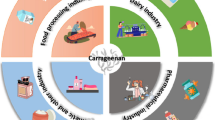Abstract
The contents of seven different phenolic acids such as gallic acid, catechinic acid, pyrocatechol, caffeic acid, coumaric acid, ferulic acid and benzoic acid in the poplar leaves (Populus Simonii × Populus Pyramibalis c. v and Populus deltoids) suffocated by Methyl jasmonate (MeJA) and Methyl salicylate (MeSA) were monitored for analyzing their functions in interplant communications by using high-pressure liquid chromatography (HPLC). The results showed that the contents of phenolic acids had obviously difference in leaves exposed to either MeSA or MeJA. When P.deltoides leaves exposed to MeJA or MeSA, the level of gallic acid, coumaric acid, caffeic acid, ferulic acid and benzoic acid was increased, gallic acid in leaves treated with MeJA comes to a peak at 24 h while to a peak at 12-d having leaves treated with MeSA. When P. Simonii × P. Pyramibalis c. v leaves were exposed to MeJA or MeSA, the level of gallic acid, pyrocatechol and ferulic acid was increased; The catechinic acid and benzoic acid had a little drop; The caffeic acid and coumaric acid were undetected in both suffocated and control leaves. This changed pattern indicated that MeJA and MeSA can act as airborne signals to induce defense response of plants.
Similar content being viewed by others
References
Abou-Zaid, M.M., Beninger, C.W., Arnason, J.T., Nozzolillo, C. 1993. The effect of one flavanone, two catechins and four flavonols on mortality and growth of the European corn borer (Ostrinia nubilalis Hubner) [J]. Biochem. Syst. Ecol., 21: 415–420.
Bajaj, K.L. 1998. Biochemical basis for disease resistance-role of plant phenolics [C]. In: Singh, R., Sawhney, S.K. (eds),. Advances in frontier areas of plant biochemistry. New Delhi: Prentica-Hall of India Private Limited, p487–510.
Baldwin, I.T., Schultz, J.C. 1983. Rapid changes in tree leaf chemistry induced by damage: evidence for communication between plants [J]. Science, 221: 277–278.
Dempsey, D.M.A., Shah, J., Klessig, D.F. 1999. Salicylic acid and disease resistance in plants [J]. Crit. Rev. Plant. Sci., 18: 547–575.
Dicke, M. 1999. Are herbivore-induced plant volatiles reliable indicators of herbivore identity to foraging carnivorous arthropods? [J]. Entomol. Exp. Appl., 91: 131–142.
Dick, M., Bruin, J. 2001. Chemical information transfer between damaged and undamaged plants [J]. Biochem. Syst. Ecol., 29: 979–980.
Dixon, R.A., Paiva, N.L. 1995. Struess-induced phenylpropanoid metabolism [J]. The Plant Cell, 7: 1085–1097.
Farmer, E.E., Ryan, C.A. 1990. Interplant communication: airborne methyl jasmonate induces synthesis of proteinase inhibitors in plant leaves [J]. Proc. Natl. Acad. Sci., 87: 7713–7716.
Farmer, E.E., Weber, H., Bollenweider, S. 1998. Fatty acid signalling in Arabidopsis [J]. Planta, 206: 167–174.
Harborne, J.B. 1994. Introduction to Ecological Biochemistry, 4th edn. [M]. New York: Academic Press.
Higuchi, T. 1997. Biochemistry and molecular biology of wood [M]. Berlin Heidelberg New York: Springer-Verlag, p131–236.
Karban, R., Baldwin, I.T., Baxter, K.J., Laue, G., Felton, G.W. 2000. Communication between plants: induced resistance in wild tobacco plants following clipping of neighboring sagebrush [J]. Oecologia, 125: 66–71.
Lambers, H., Chapin III, F.S., Pons, T.L. 1998. Plant Physiological Ecology [M]. New York: Springer-Verlag, p413–436.
Li Huiping, Wang Zhigang, Yang Minsheng, et al. 2003. The relation between tannin and phenol constituents and resistance to Anoplophora glabripennis of various poplar tree species [J]. Journal of Agricultural University of Hebei, 26(1): 36–39. (In Chinese)
Mauch-Mani, B., Slusrenko. 1996. Production of salicyclic acid precursors is a major function of phenylalanine ammonia-lyase in the resistance of Arabidopsis to peronospora parasitica [J]. The Plant Cell, 8: 203–212.
Mieczyslaw, K., Marzanna, S.W., Jeffrey, M.L., Alicja, M.Z. 1999. Cytochemical localization of phenolic compounds in columella cells of the root cap in seeds of Brassica napus-changes in the localization of phenolic compounds during germination [J]. Annals of Botany, 84: 135–143.
McConn, M., Creelman, R.A., Bell, E., Mullet, J.E., Browse, J. 1997. Jasmonate is essential for insect defense in Arabidopsis [J]. Proc. Natl. Acad. Sci., 94: 5473–5477.
Paré, P.W., Tumlinson, J.H. 1999. Plant volatiles as a defense against insect herbivores [J]. Plant Physiol., 121: 325–331.
Ryan, C.A. 2000. The systemin signaling pathway: differential activation of defensive genes [J]. Biochem. Biophys. Acta., 1477: 112–122.
Shah, J., Klessig, D.F. 1999. Salicylic acid: Signal perception and transduction [C]. In: Libbenga, K., Hall, M., Hooykaas, P.J. (eds), Biochemistry and Molecular Biology of Plant. Hormones Oxford: Elsevier, p513–541.
Shulaev, V., Silverman, P., Raskin, I. 1997. Airborne signalling by methyl salicylate in plant pathogen resistance [J]. Nature, 385: 718–721.
Stafford, N.A. 1988. Proanthocyanidins and the lignin connection [J]. Phytochemistry, 27: 1–6.
Wagner, M.R. 1988. Induced defenses in ponderosa pine against defoliating insects [C]. In: Mattson, W.J., Levieux, J., Bernard-Dagan, C. (eds), Mechanism of woody plant defenses against insects. New York: Springer-Verlag, p141–155.
Author information
Authors and Affiliations
Corresponding author
Additional information
Foundation item: This research is supported by National Natural Science Foundation of China (No.30170764)
Biography: AN Yu (1982–), female, postgraduate in College of Biological Sciences and Biotechnology, Beijing Forestry University, Beijing 100083, P. R. China.
Rights and permissions
About this article
Cite this article
An, Y., Shen, Yb., Wu, Lj. et al. A change of phenolic acids content in poplar leaves induced by methyl salicylate and methyl jasmonate. J. of For. Res. 17, 107–110 (2006). https://doi.org/10.1007/s11676-006-0025-1
Received:
Accepted:
Issue Date:
DOI: https://doi.org/10.1007/s11676-006-0025-1




